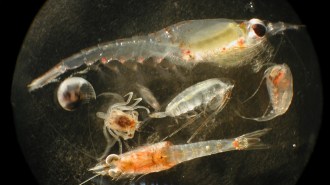- More than 2 years ago
About 76 percent of a commonly used antimicrobial agent exits sewage-treatment plants as a component of the sludge that’s often used as a farm fertilizer, according to the first study to track the chemical through a typical plant. The finding raises questions as to the ultimate fate of the antimicrobial in the environment, the study’s authors say.
U.S. manufacturers add 500,000 to 1 million pounds of the chemical triclocarban each year to personal-care products, such as antimicrobial soaps. Past toxicological studies have linked the chemical to decreases in birthweight and survival in rats and rabbits, says Rolf U. Halden of Johns Hopkins University in Baltimore.
Halden and his colleagues followed triclocarban through a treatment plant that takes in 680 million liters of wastewater per day produced by 1.3 million residents of a city in the mid-Atlantic region. The plant separates the sewage into liquid and solid streams, and microbes break down much of the organic content of those flows.
According to the National Academies in Washington, D.C., U.S. treatment plants send about 60 percent of the solid sludge that they generate to agricultural fields and other land as fertilizer. Liquids leaving the plants typically flow into streams or other bodies of water.
The group determined the quantity of triclocarban in samples of the incoming sewage and outgoing liquid and sludge. “It’s difficult analyzing the sludge,” says Halden. “In the past decade, the appropriate instrumentation has become available.”
In an upcoming Environmental Science & Technology, the team reports that microbes broke down only about 21 percent of the triclocarban entering the treatment plant. About 76 percent accumulated in the sludge, and another 3 percent remained in the liquid stream.
“If a consumer goes to the supermarket and buys a bar of soap, three-quarters of the active ingredient could end up in agriculture because the sludge is being recycled,” says Halden.
The researchers estimate that from sludge released solely by the plant that they studied, more than 1,000 kilograms of triclocarban enter the environment each year. Scientists haven’t yet discerned whether the chemical degrades or accumulates in soils or what its effects are on natural soil microbes, says Halden. “We don’t know if it’s being taken up by plants and migrating into the food supply,” he adds.
“This finding suggests potential problems due to the high usage rate of triclocarban in the U.S.,” says Craig D. Adams, an environmental engineer at the University of Missouri–Rolla.
With the new insight on what quantities can be expected in the environment, researchers can now turn to assessing the chemical’s risk, says chemist Diana Aga of the State University of New York at Buffalo.
Although the Environment Protection Agency hasn’t endorsed a method for detecting triclocarban in sludge, Rick Stevens, EPA’s national biosolids coordinator, says that the results “are the kind of thing that raises interest.”







